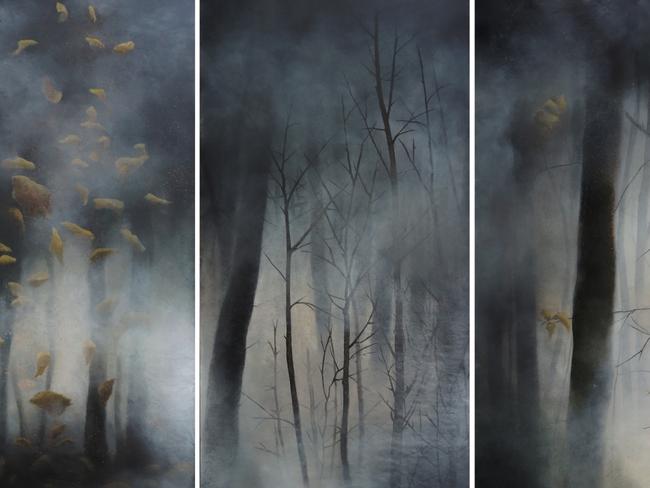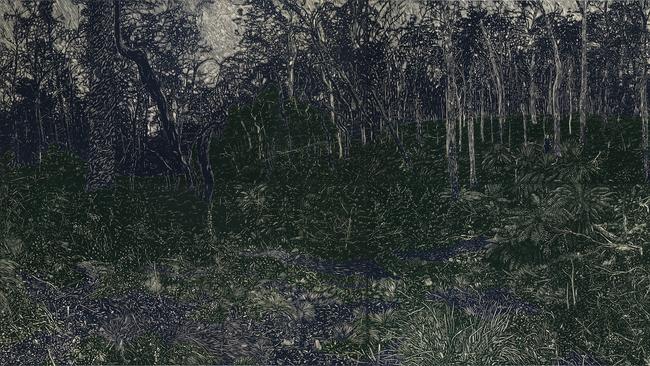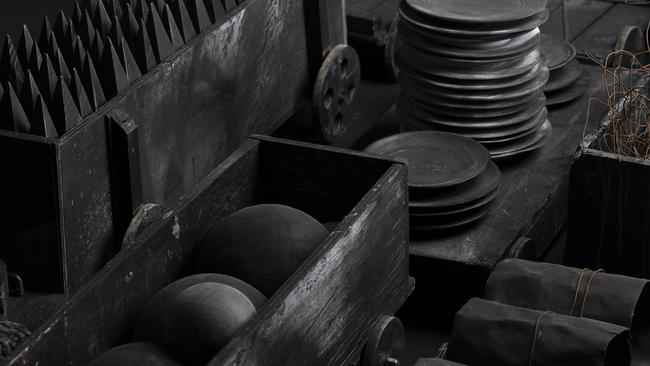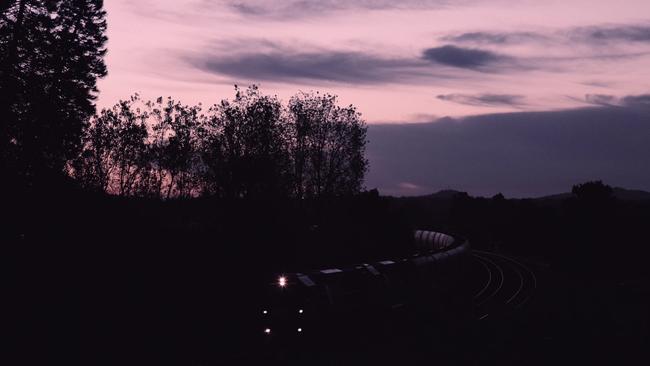Review of Upriver Downriver at Maitland Regional Art Gallery
A strikingly effective, harmonious and well-hung exhibition of art from the Hunter River region affirms local galleries as vibrant hubs for intellectual stimulation.

Rivers are vital to natural ecosystems, but crucial also to social and economic life and thus play a fundamental role in human history. I still recall the first important geography lesson in my French school – no doubt barely changed from the Napoleonic-era drafting of the curriculum – about the five great rivers of France: the Seine, the Loire, the Garonne, the Rhône and the Rhine.
Historians have always understood the importance of rivers: it was Herodotus who called Egypt the gift of the Nile. And much earlier they are prominent in myth, poetry and spiritual traditions; in the Biblical story, four rivers issued from the Garden of Eden, and this gave rise to an iconography of rivers, most famously perhaps in Bernini’s Fountain of the Four Rivers in Piazza Navona.
In earlier versions, they were often identified as the Tigris, the Euphrates, the Nile and the Tiber, celebrated as the river of Rome although far smaller than the others. Bernini’s four rivers have been radically revised to represent the four continents: the Danube for Europe, the Ganges for Asia, the Nile for Africa and the Rio de la Plata (not, as often assumed, the Amazon) for America.
Of all these rivers, the one most universally known remains the Nile, but I was surprised recently when some otherwise well-educated young people failed to recognise the Rhine and the Danube, the two great rivers which, both arising in the Alps, span the European continent from the North Sea to the Black Sea and are today connected by the Rhine-Main-Danube Canal. Even fewer probably recognise the Tigris and the Euphrates, the Indus and the Yellow River which, with the Nile, were the birthplaces of human civilisation.
Australia is not as fortunate as Europe in its waterways, either from the point of view of agriculture or of transport; we have relatively few navigable rivers and the perennial streams that are ubiquitous in France or England are rare here.
There are some rivers that flow into the sea on the east coast – the Hawkesbury and the Shoalhaven bounding the Sydney region, the Yarra in Melbourne and the Brisbane in the city of the same name. But our greatest river system, the Murray-Darling, flows inland from the Great Dividing Range and southwest into the Great Australian Bight.
This became our most important agricultural region, although the overexploitation of water for irrigation, sometimes for crops that are unsustainable in this environment, has caused a crisis that is yet to be resolved. Modern agriculture has transformed a region that once supported a few thousand people into one that today feeds millions, but that transformation has come at a severe environmental cost. It should be possible to review the whole process, eliminate unsustainable crops and improve water conservation, fertiliser use and other practices for those crops that can be maintained and developed in the long term.
The eastern rivers, though comparatively small, played an important part in the early history of settlement. The Hawkesbury, in particular, was explored as early as 1789, and the first settlement at Windsor dates from around 1791, though the town itself was proclaimed by Governor Macquarie in 1810. The fertile areas around Windsor and at Saint Albans on the Macdonald River, a tributary of the Hawkesbury, provided much-needed agricultural land, and ships could carry the produce back to Sydney Cove.
Soon, however, interest turned to the much more expansive farming opportunities in the Hunter Valley to the north. The Hunter River, with its abundant coal deposits, was discovered in 1797 and named for Vice Admiral John Hunter, the second governor of NSW; a few years later a secondary penal colony was established there and the convicts were put to work extracting coal. Governor Macquarie proposed closing the penal colony in 1820, and this was finally achieved under Governor Brisbane in 1823, opening the area to free settlement.
The building of the Great North Road, the first important engineering project in the history of Australia, began soon afterwards.
It was constructed by convict labour from 1825 to 1836, leading from Parramatta Rd to Wiseman’s Ferry, and from there north to the Hunter Valley, one branch continuing north from Wollombi to Broke and Warkworth and the other turning northeast to Cessnock, Maitland and then southeast to Newcastle.
The Great North Road was, however, soon superseded by shipping, especially with the appearance of steamships. And because the Hunter River was navigable by seagoing ships up to Maitland, this became the centre for unloading cargo and transferring it to smaller vessels for the voyage further upstream. So Maitland grew into a regional commercial and trading centre, and in fact long had an important Jewish community, whose former synagogue is immediately recognisable by its use of neo-Romanesque style, preferred to the neo-Gothic used in Christian churches.
Today Maitland has, among other attractions, a fine regional art gallery, which occupies a handsome Federation building, the former Maitland Technical College (1910), and was extended by a spacious new wing, opened by Margaret Olley in 2009. The gallery is currently fully occupied by an extensive survey devoted to artists of the Hunter River region, appropriately titled Upriver Downriver.
Considering how disparate a group of artists selected on the basis of residency can be, this is a strikingly effective, harmonious and well-hung exhibition, with many interesting things to discover and few jarring notes. The works in the show have in general a strong sense of locality and place, without feeling provincial, reflecting no doubt the long history of the Hunter region and the importance of Newcastle as a centre which is often underestimated in Sydney.

Some of the most impressive works in the exhibition evoke the natural environment of the Hunter. Particularly striking is Graham Wilson’s huge engraved landscape on birch plywood which looks as if it is designed to produce a gigantic woodblock print. The technique, however, is not in fact like woodblock, where the surface is cut away around the motif, but closer to wood engraving, in which forms are defined by many smaller internal cuts within the form of the subject. Thus, here, tree trunks are constituted not as dark forms set against a white surround but rather as patterns of white incisions in the uniform dark of the background.
The boards have evidently been painted in dark background colours first, corresponding the broad sections of the composition, and then the individual shapes have been established by a long and painstaking process; it is the fact that the birch wood is so light in colour that allows the final result to emulate a wood engraving. And the overall effect, in which forms emerge from a continuous ground, is well suited to evoking the complex forest view represented.
Another work that captures the sense of an ancient and embracing natural environment is Hannah Kay’s series of oil and tempera paintings on Chinese rice paper that hang on four sides of a small space upstairs. We have the feeling of an unfolding bush landscape all around us – the density of the medium contrasting with the lightness of the support – but an element of time as well as space is added by the subtle and yet impressive play of changing light effects, from dusk to darkness and then the return of light again.
The patient attention to the life of nature that is expressed differently in both of these works is also evident in a large pencil drawing by Nicola Hensel and several paintings and drawings by Alessia Sakoff, incidentally reminding us that Newcastle University offers a Bachelor of Natural History Illustration.
There are striking pieces, too, by Todd Fuller, Nigel Milsom and Vera Zulumovski. At the more conceptual end of the spectrum there are memorable examples of visual poetry and word art by Richard Tipping, including one in the stairwell of the old building and what looks like a roadside work sign as you approach the gallery: “End Artwork”.
One of the most interesting aspects of this exhibition is the way that several pieces deal with the inevitable part played by coal in the history of this region and its communities. To the gallery’s credit this theme is handled without editorialising or breast-beating. We are well aware of the environmental crisis and the problems of burning fossil fuels; in this as in other matters, it is much better to trust in the intelligence of viewers than to lecture them.
Two works by Brett McMahon stand out in this regard. Cargo is like a collection of rail freight cars, or those miniature carts that used to run on tracks in coal mines, pushed along by hand through narrow tunnels. But at the same time the forms are odd and idiosyncratic enough to resist a merely illustrative or documentary interpretation; they could be carrying other kinds of goods, but everything is painted black, as though metamorphosed into coal.

Where simple decoding or translation into conceptual, let alone ideological terms is unavailable, imagination is left, indeed provoked to dream. In another notable floor piece, McMahon has apparently reproduced a natural geological formation in which coal, lying in shallow seawater, forms a strange landscape of cubic steps.
Nearby is a final work evoking the theme of coal: Dusk, a video by Shonah Trescott and Osvaldo Budet, appropriately shot in black and white. It is a film of a coal train winding through a hilly landscape in the half-dark; the view alternates between long shots of the landscape in which the fading light catches the sides of the articulated cars, reminding one of the segments of a centipede, and closer shots from the side and especially from above, looking down into the endless succession of cars filled with the fossilised remains of what were great trees in the age of the dinosaurs.

Visiting the gallery a couple of weeks ago, I was reminded, as I was in Benalla last year, how vitally important these institutions are in regional cities. They are not simply repositories of a local art collection – although it is eminently worth building thoughtful collections of the art that grows out of and speaks to a region – or indeed places to show self-curated or travelling exhibitions. They are also centres, focal points or nodes for the artistic and intellectual life of the city and its hinterland.
Churches, libraries, clubs and societies may all play similar roles, but often in a more specialised or intermittent way. Only the art gallery is open every day; a place where you can meet like-minded friends for coffee, visit an exhibition together, attend a lecture, read a book in the reference library or perhaps listen to a concert. In a regional city, an art gallery equipped with all these facilities is not just a service to the population but positively contributes to building culture and community.
Upriver Downriver, Maitland Regional Art Gallery, until August 13.


To join the conversation, please log in. Don't have an account? Register
Join the conversation, you are commenting as Logout